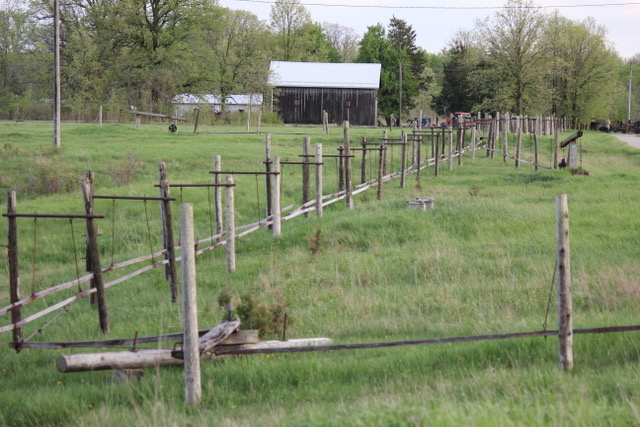
Still in use around the clock at Fairbank Oil, the jerker line delivers power to the wells. Here we use wood for the jerker line but other Oil Springs producers use cable.
Exactly 160 years ago, John Henry Fairbank devised a game-changing technology for oil wells in booming Oil Springs. Remarkably, it is still being used daily throughout Oil Springs today and currently four wells at the Petrolia Discovery.
Fairbank devised the jerker-line system to power the wells; a major leap forward from the spring pole method which needed men to continually stomp on it. Portable steam engines were sometimes used but in the swampy tangled wood of Oil Springs this was both difficult and expensive.
The jerker line liberated the oilmen from exhausting physical labour and made oil production much more cost-effective. Keeping costs down is essential. Like farmers, oil men do not control the selling price. They can only control their expenses in producing the crude.
By hooking wells together, it allowed 20 wells or more to use one steam engine. Instantly, it slashed a producer’s costs and made them sustainable, even during times of wildly fluctuating oil prices.
Reducing the cost of pumping oil was a huge advancement. This multiple pumping system became known as the jerker rod system and it was universally adopted all over Oil Springs and later Petrolia. It had quickly evolved into building power stations known as rigs, then transferring the power through the jerker. Until 1918, coal fuelled the massive steam boilers of the rig. Oilmen were relieved when electricity arrived in Oil Springs.
In 1890, Fairbank told the Ontario Royal Commission of the jerker’s history. “I had a well too hard to work by man power. I hadn’t an engine but there was engine power within reach and I applied the jerker system.” The jerker system was not patented and Fairbank said he did not know it could be. The system only worked on the shallow oil fields of Oil Springs and Petrolia. It would not work in Pennsylvania where the wells are deeper.
Today, the jerker line at Fairbank Oil powers almost half of its 320 wells. The Big Rig, built here in the early 1900s, powered as many as 200 wells before it burned in 1961. Now, the six rigs each power 30 wells or usually fewer. If the jerker line at Fairbank Oil was laid out end-to-end it would measure about 11 km. One visitor watching it swing back and forth called it “stunningly archaic”.
With the passage of time, it has become more challenging to operate. For many years the wood of the black ash tree was used because it was abundant and a strong hardwood with a narrow straight grain that could hold the bolts needed. But the black ash largely disappeared from here about 100 years ago. Fir was also used. In recent times the white ash wood has been used but the white ash has been decimated by the emerald ash borer. Hardwoods must be used and but they are heavy and can break. Repairing them can cost a lot of man hours.
From the rig, the power is transferred to the outside by long wooden rods forming the double jerker line. The 16-foot (4.8-m) rods is cut into two by twos and joined by metal plates. They run parallel to the ground and about eight inches (20 cm) above it, suspended by iron hangers. It’s a system that blends into the landscape.
The jerker line “sings” or “jerks” back and forth much like a pendulum. This “singing” is forever changing with wind and weather, and is best heard at night when the air is still. It is an intangible aspect of the oil heritage. This authentic sound, like the birdsong heard in the oilfield, is unchanged from the 1860s. A visitor once said that an impressive tour of Alcatraz included headphones with manufactured sounds of the famous prison. No headphones are needed at Fairbank Oil.
Some people watching the jerker find that the slow rhythm is calming, almost hypnotic, moving at 11 beats per minute, the same speed as relaxed breathing.
It’s easy to see the jerker line in Oil Springs. Just take the Driving Tour along Gum Bed Line, Gypsie Flats Rd. or as you approach our barn on Duryee Street. This marvel of technology has been operating for 160 years. John Henry Fairbank would be impressed.
